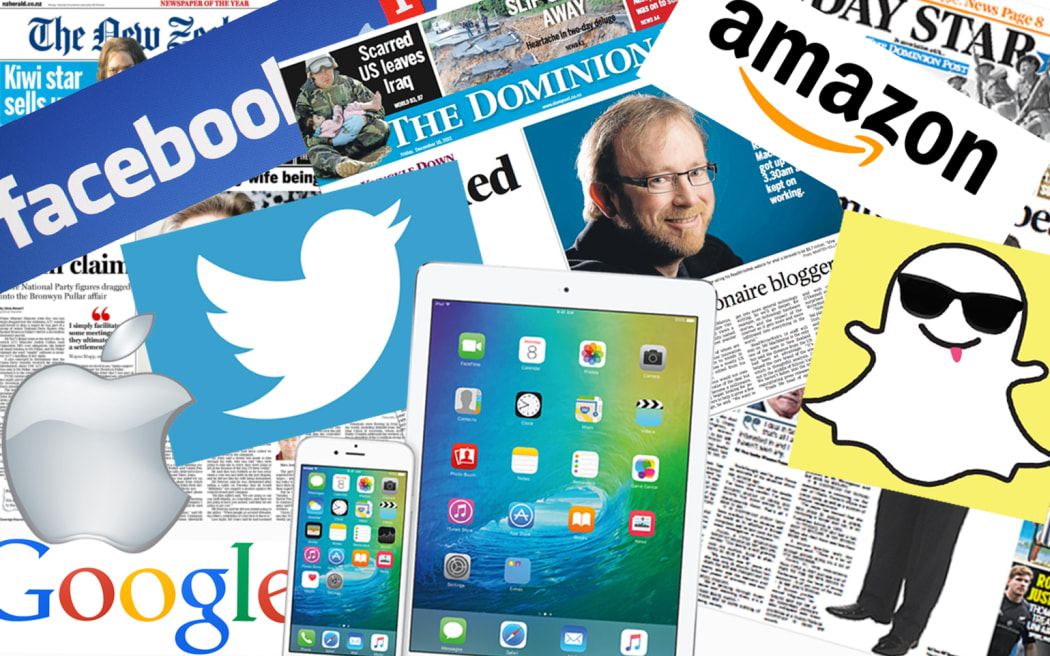OPINION: This week I had the privilege of speaking to a class of journalism students at Massey University's Wellington campus. They were a bright and highly motivated bunch, although somewhat nervous about what the future holds. My task was to talk about what is happening in the media industry and to advise them on how to find a toe-hold in the fast-changing news business.

Audiences today are as likely to be on Facebook or Snapchat as traditional media platforms. Photo: RNZ
I gave both an honest assessment and a positive message: the industry is under pressure and is undergoing unprecedented change but there is still a demand for skilled journalists who are passionate about breaking and telling important stories and engaging with audiences. I hope I managed to convey a sense of hope and, if nothing else, Radio New Zealand's ongoing commitment to credible, relevant news and current affairs.
The news industry is big and mostly bad news these days. It seems almost impossible to pick up a paper, listen to a news programme, or go on Twitter or Facebook without encountering the latest chapter in the media's tale of woe. You know the headlines - advertising revenues down, newsrooms squeezed, the looming death of high-quality journalism.
In New Zealand attention has focused on the high-profile demise of Campbell Live, even though behind the scenes nearly every media organisation is shedding staff and constantly reviewing and refreshing what they produce.
Occasionally there is a brighter note such as the announcement this week that Apple is throwing a lifeline to news outlets by creating an app that promises to deliver content from a range of credible sources to your smartphone, tablet or PC. The fact this has been welcomed by most news organisations shows how far we have all travelled in the past few years. There was a time, not so long ago, when news outlets not only created and commissioned the journalism, they also jealously guarded its distribution.
Nowadays we are often just desperate to get it front of audiences, wherever they happen to be. And they often happen to be on Facebook, or on their iPhone or Snapchat. So what if we are handing over our work, and our relationship with our readers, listeners and viewers, to the tech titans Apple, Google, Amazon and Facebook?
The alternative - increasing irrelevance as we fall further behind audience behaviour - is even more frightening. I suspect we may be now entering a fourth media age - one characterised by the atomisation of news and its re-distribution by global content ecosystems, such as Apple and Facebook.
The first media age lasted decades and was centred on the coherence and commercial robustness of the bundled product - newspapers, magazines, television schedules - which packaged together a range of information. In those heady days, which lasted 'til the 1990s, information was scarce and expensive to distribute. Media outlets reaped strong profits from their control of printing presses, delivery trucks, TV and radio frequencies and the like.
In those days, if you wanted to find a tenant for your flat you needed to pay the local paper to print your advert tens of thousands of times to reach the dozen people who might be interested in renting the property.
The second media age was triggered by the invention and rise of the worldwide web, the uber-network no one owns or controls. This made it easy and cheap to instantly distribute an abundance of content. The desktop started to pull apart the bundle. Finding that tenant was suddenly cheaper and more targeted thanks to Trade Me.

John Campbell at a rally which aimed to save his show, outside the MediaWorks building in Auckland last month. Photo: RNZ / Tiana Barns
The third media age, which started after 2005, has been dominated by the triumph of social media and the growth of mobile and cheaper and better broadband. These changed the game again and further empowered people to create, share and access information quickly, easily and on the move.
This third age has been both painfully disruptive for media outlets while also enormously liberating for society, and has given us such things as video-on-demand, app stores, streaming music services and the Arab Spring.
And now we are at a new dawn with tech companies trying to insert themselves between the news outlet and the audience. This is exciting as it potentially makes possible a new age of journalism in which the creators and curators of news and current affairs work collaboratively with the smartest and best-resourced companies in the world. The possibility of these new partnerships endorses the on-going vital importance and the appeal of journalism.
We are all keen to see whether we can work with the tech titans to reach mass audiences in a commercially sustainable fashion. The risks are high but it is probably no riskier than standing still.
As I told the Massey students, verified journalism produced by skilled professionals remains the oxygen of a healthy, open society. We have no choice but to be more innovative and collaborative about how we create it and then get it to the people.





